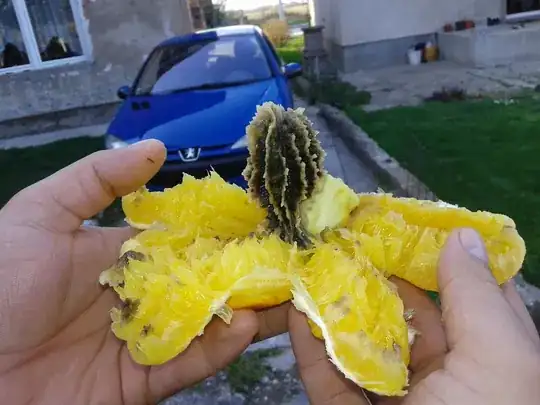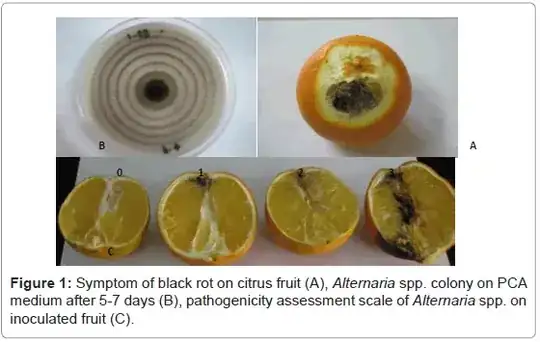So, inside this orange there is this "alien" thing. Before I want to say that this is GMO, I need an reasonable explanation about this. What is this thing?
-
10What a great 'alien'! Not something that would distinguish GMO from a natural orange. GMO attempts to perfect nature, make it better. This will be interesting to discuss! – stormy Apr 08 '18 at 18:34
-
Definitely not a gmo. Also, adding information such as you're general location might be helpful. And if you don't get a good answer and you still have it, you can visit your local university's ag or bio program and ask them about it. – tox123 Apr 08 '18 at 23:25
-
2You need to give us more information: **(A)** how old was the orange? **(B)** was the orange seedless? **(C)** a photograph of the outer rind — _i.e._ the underside in that photograph. **(D)** how, exactly, did you prepare the orange? **(E)** what does the green thing feel like? **(F)** don't sniff it too deeply, but please describe the odor. I'd wish to upvote, but we need more info. – can-ned_food Apr 09 '18 at 01:47
-
3Note: oranges are not natural, but gone long selection (and crossing) by humans. So it is genetically (and physiologically) not stable, especially on old plants. As far I know, there is no GMO orange (but just non-GMO marketing [which means "terrorism" to consumer]). It is also difficult to do GMO on long living individual (as I wrote old plants "changes", before to commercial use orange GMO, one should be sure that after 20 years one can still harvest GMO oranges. So longer testing, more costs. [coffee could be the exception, because of coffee crisis] – Giacomo Catenazzi Apr 09 '18 at 05:57
-
@can-ned_food (B) There are several seeds visible in the segment of the orange near the asker's right palm. – David Richerby Apr 09 '18 at 10:16
-
3Ironically, from the answers posted so far it seems like the answer is closer to "Because it's _not_ GMO". – pipe Apr 09 '18 at 11:13
-
2Please mark NSFW. – Tobia Tesan Apr 09 '18 at 11:30
-
2That image is giving me the same adverse reaction that I get from Trypophobia-triggering images for some reason. Considering Trypophobia reactions seem to be caused by poison/rot indicators, it makes sense that its a type of disease. – Carcigenicate Apr 09 '18 at 15:10
-
Got an Indian Bitter melon vine growing up the tree? https://duckduckgo.com/?q=indian+bitter+melon&t=ffsb&iax=images&ia=images – Wayfaring Stranger Apr 09 '18 at 15:34
-
How did it taste? – Eric Duminil Apr 09 '18 at 16:49
-
This photo would fit well with photos of weeds in my yard... – VividD Apr 12 '18 at 16:50
2 Answers
Preface: This answer is based solely on the search result. I'm not a gardener and I don't have any gardening knowledge to sufficiently answer this with full certainty.
Looking at the picture, it seems the most prevalent thing is the blackening of the core. Researching that gave results to a similar symptom from Alternaria/Black rot. This is caused by Alternaria spp. (e.g. Alternaria citri, Alternaria alternata), a fungal plant pathogen.
Some research papers on this:
Citrus Black Rot is Caused by Phylogenetically Distinct Lineages of Alternaria alternata

Fig. 1. Sweet orange ( Citrus sinensis ) inoculated with conidia of Alternaria alternata and evaluated 21 days postinoculation for symptoms of black rot. A, Unwounded and surface inoculated with isolate LM rot-1, black rot rating = 0; B, wounded and inoculated with isolate RL spot-4, black rot rating = 1.0; C, wounded and inoculated with isolate LM rot-1, black rot rating = 2.0; D, wounded and inoculated with isolate OR citri-1, black rot rating = 3.0.
Phylogenetic Analysis of Alternaria species Associated with Citrus Black Rot in Iran
-
- 293
- 2
- 8
Definitely looks like something from a sci fi/horror movie! Black areas within oranges are usually caused by a fungal pathogen - it enters most often at the 'navel' end of the orange and then spreads inside the fruit in varying degrees. It most often spreads up the central area, but can appear as small black areas in some of the cells of the orange. However,there is usually a small black or brown spot on the skin outside too, and internally, the spread is definitely sooty black, not greenish grey.
I've never seen a structure like that in association with a fungal infection; it's not impossible, but it's much more likely there might be another explanation - some kind of infection (fungal or otherwise) or randomly occurring DNA disruption has caused a mutation in the cells of the orange, creating this growth, rather than its just being the usual black rot.
It's unlikely to be related to GMO - these things do occur quite naturally, including in human beings, unfortunately.
- 131,823
- 3
- 72
- 162


